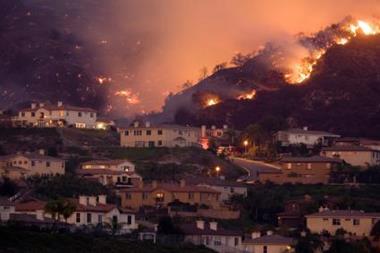Terrorism, war, natural disasters and financial ruin - the past decade saw it all. Nathan Skinner takes a look at these incidences and how the risk management world has changed as a result. For better or for worse, we'll never be the same again
Where has risk management come in the noughties? And what have been the main events that encouraged it along the way? Our ten year anniversary and the year 2010 inspired us to think about what happened in this chapter of our history that has had a bearing on the profession that we've been observing.
Without doubt there have been some world defining crises over this period that have hit the business world and forced it to reconsider the way it does things - external factors that have compelled businesses to adapt and change the way they operate in order to survive. Some of these events have been spontaneous and without warning.
Journalists and other observers have tried to put them into context. Usually these people have linked them to long term trends or seismic forces such as globalisation and climate change. Whatever their cause these events demand examination not least to give us a glimmer into the past but also to inspire us to ask questions about the future.
Technology bubble bursts, early 2000
When the technology bubble burst in early 2000, it represented a realisation that technology advancements alone could not guarantee a company’s growth. The bubble was formed by over-optimism in the future prospects of internet based companies. The bursting of the bubble, however, has not stopped the internet and e-commerce becoming one of the most powerful sales forces in modern business. Neither has it stopped the internet dominating many aspects of communication, media and advertising. Indeed the noughties have seen impressive developments in the internet, both as a medium for communication and as a business model.
September 11, 2001
September 11 is a date etched into the history of modern civilisation. Nineteen hijackers used commercial flights to launch a series of coordinated attacks on the USA, killing 3,000 victims. America's response was to launch the war on terror and enact new laws like the Patriot Act, to defend itself from hostile states. Many other countries passed anti-terror legislation and strengthened law enforcement powers. On most people and business in particular this had the effect of new bureaucratic requirements, designed to keep citizens safe. Financial services firms especially would now have to know more about who they were trading with and comply with new rules that stopped them from doing deals with some. President Bush's war on terror that culminated in a conventional invasion of Afghanistan and Iraq opened doors for some companies but has arguably made the world more dangerous by pitting two world views against each other. In a narrower sense the devastation visited on New York shocked stock markets and hit the airline and insurance industries particularly hard.
For many risk managers it meant being asked very difficult questions for perhaps the first time. Boardroom ears pricked at terrorism protection, but at the same time the insurance market was going through its worst crisis ever. The 9/11 attack cost the insurance industry in total around $40bn. It caused an unprecedented hardening of the market and made certain covers impossible to attain.
Corporate disaster, 2001
Enron and WorldCom are perhaps the two best examples of the illegal accounting practices that triggered a regulatory drive to improve corporate governance, transparency and accountability. These two spectacular and highly publicised accounting frauds inspired US lawmakers Paul Sarbanes and Michael Oxley to reform corporate law for publicly listed companies. Debate still rages about the benefits of the rules, particularly considering the mammoth costs of compliance and their perceived failure in light of the most recent round of corporate failures. The effect of SOX, as it is termed, and subsequent reforms around the world, has been to increase emphasis on governance codes. This has been good for risk managers who have benefited from the heightened importance of internal controls and risk management.
Enron and Worldcom can also be seen as the start of a trend in favour of increasing the professionalism of non-executive directors, although there may still be a long way to go. They also led to the development of corporate governance laws, risk management standards and internal control frameworks in many other parts of the world. The increased emphasis on corporate accountability, including the prospect of strict personal fines and long sentences, encouraged directors to consider their behaviour more closely. It also inspired greater interest in directors’ and officers’ (D&O) insurance. Again risk managers were asked to step up and the smart ones used D&O as a way of getting the board’s attention and respect. But as with any commodity demand pushed the price of D&O up.
Hurricanes Katrina, Rita and Wilma, 2005
The Atlantic hurricane season of 2005 was the most destructive in recorded history. Hurricanes Katrina, Rita and Wilma were three of the deadliest in an unprecedented storm season that killed almost 4,000 people and cost $130bn. Hurricane Ivan in 2004, itself the 10th most intense Atlantic hurricane every recorded, meant the insurance industry was already in a state of recovery from steep losses. The 2005 hurricane season resulted in a brutal hardening of the natural catastrophe insurance market and made certain exposures in the Gulf of Mexico uninsurable.
For risk managers it fundamentally changed their relationship with the reinsurance market as the latter’s decisions would now have an impact on what insurances became available. Beyond the insurance market the devastation wrought by Mother Nature focused attention on the effects of climate change on severe weather. Was global warming increasing the incidents of extreme natural catastrophes? This in turn bolstered the argument for taking action now against carbon emissions. Public scrutiny and the drive for new environmental regulations, to counter pollution, environmental destruction and greenhouse gas emissions, have strengthened considerably in past decade. The green movement has also opened up new business opportunities and inspired many sustainable enterprises.
Financial crisis, 2008
September 2008 was easily the most dramatic month in the history of global financial markets. Each day news wires were buzzing with information about the latest banking disaster. A sub-prime mortgage bubble in the US caused asset prices to collapse and hundreds of banks around the world collapsed. Governments around the world were forced to pump trillions into the financial system to prevent large financial institutions from collapsing because they posed a systemic risk. Despite their best efforts central banks could not prevent the global economy slipping into recession, now considered by many to be the worst in living memory. Unlike other global events of the past the financial crisis of 2008 has not affected the insurance market dramatically (see chart), with the exception of the notable collapse of AIG and severe losses at some other large insurers, like Swiss Re and XL. It has not had the hardening effect on the insurance market, outside of financial lines, which some predicted. This could be a result of the recession and the fact that consumers do not have the cash to spend on financial services like insurance while businesses are generally doing less insurable trade.
For the risk management profession, however, the financial crisis has been defining. New corporate governance codes, drawn up specifically in its wake, as well as, once again, the increased focus on corporate governance, have shone a spotlight on the profession. This could be both good news and bad news. The bad news comes in the form of the perceived failure of risk management. Practitioners defend risk management by saying it was a failure to apply the concept. It is clear that human judgment and complicated mathematical models made things more difficult. The good news is that businesses are prepared to pay much more attention to risk management and this is an opportunity for diligent risk managers to step up and advance their careers.


















